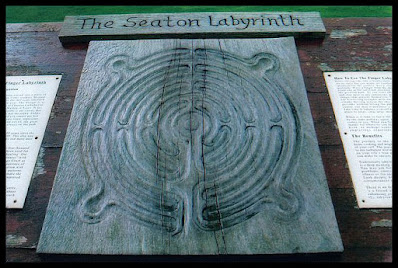This sort of labyrinth is known as a Turf Maze. The word maze is a bit of a misnomer though, as it indicates a puzzle with false paths and many dead ends. A labyrinth, on the other hand, is unicursal, consisting of just one path to be walked from beginning to end.
The Seaton Labyrinth was cut to commemorate the town millenium and opened on 24th August 2005. Based upon the mediaeval, it is an eleven circuit layout combining the designs of those at Chartres Cathedral and at Saffron Walden, but like many modern labyrinths it includes materials and aspects appropriate to the area.
The path divides are made from materials taken from local quarries along the Jurassic Coastline, the World Heritage Site that Seaton is part of. Large Amonites from the coastline fossil beds have been incorporated in the four corner loops (known as lobes) and the central slab is made from Portland Stone.
As seen in the above photos, pebbles are also part of the setting for the amonites. As well as our own pebble beach the area geology includes pebble beds and they've been used extensively in vernacular buildings. An old Devon word for pebble is popple, hence the name of Newton Poppleford village further westwards, the name of which means 'new settlement by pebble stream'.
An interpretation board, explaining the geology and how it relates to the coastline, plus a wooden carved finger labyrinth, are also on site. Intended as a meditative walk, it relates to the twists and turns of life's journey and the things we learn on the way. And it works, too! I tried it out and gained a lot more from it than I'd expected. A lovely and unusual experience.
Such an incredible setting too, overlooking Lyme Bay with a view of White Cliff and Beer Head.












No comments:
Post a Comment